Introduction
As organizations increasingly recognize the transformative potential of cloud technology, the migration to cloud-based solutions has become a pivotal strategy for enhancing operational efficiency and driving innovation. With a staggering 66% of total spending in cloud services attributed to major players like AWS, Microsoft Azure, and Google Cloud, the urgency for businesses to adapt has never been clearer.
This article delves into the multifaceted aspects of cloud migration, offering insights into its necessity, strategic frameworks such as the 7 Rs model, and practical steps for a successful transition. Moreover, it emphasizes the critical importance of security and compliance in safeguarding sensitive data throughout the migration process.
By exploring these vital components, organizations can navigate the complexities of cloud migration and harness its full potential to maintain a competitive edge in an ever-evolving digital landscape.
Understanding the Need for Cloud Migration
Organizations increasingly transition to online platforms by moving on premise to cloud to unlock a myriad of benefits, including enhanced scalability, reduced IT costs, improved collaboration, and increased operational efficiency. Key drivers of moving on premise to cloud include:
- The necessity for flexible resource allocation
- The ambition to leverage advanced technologies
- The demand for remote access to applications and data
Significantly, AWS, Microsoft Azure, and Google Cloud represented 66% or $78.1 billion of total expenditure in Q4 2023, emphasizing the substantial investment in solutions and the extensive adoption among enterprises.
Furthermore, Veeam emphasizes that
The online environment plays a crucial role in today’s data protection strategy, according to half of the surveyed businesses.
This statement highlights how moving on premise to cloud services not only enhances operational efficiency but also promotes digital transformation and innovation, crucial for sustaining a competitive advantage in a rapidly changing marketplace. For instance, Oracle Cloud differentiates itself with adaptive intelligence that helps identify market trends and improve customer experience, thereby enhancing competitive advantage and customer satisfaction.
To effectively navigate the transition of moving on premise to cloud, entities should conduct a thorough assessment of their current IT infrastructure and identify specific pain points, which will illuminate the motivations driving their journey.
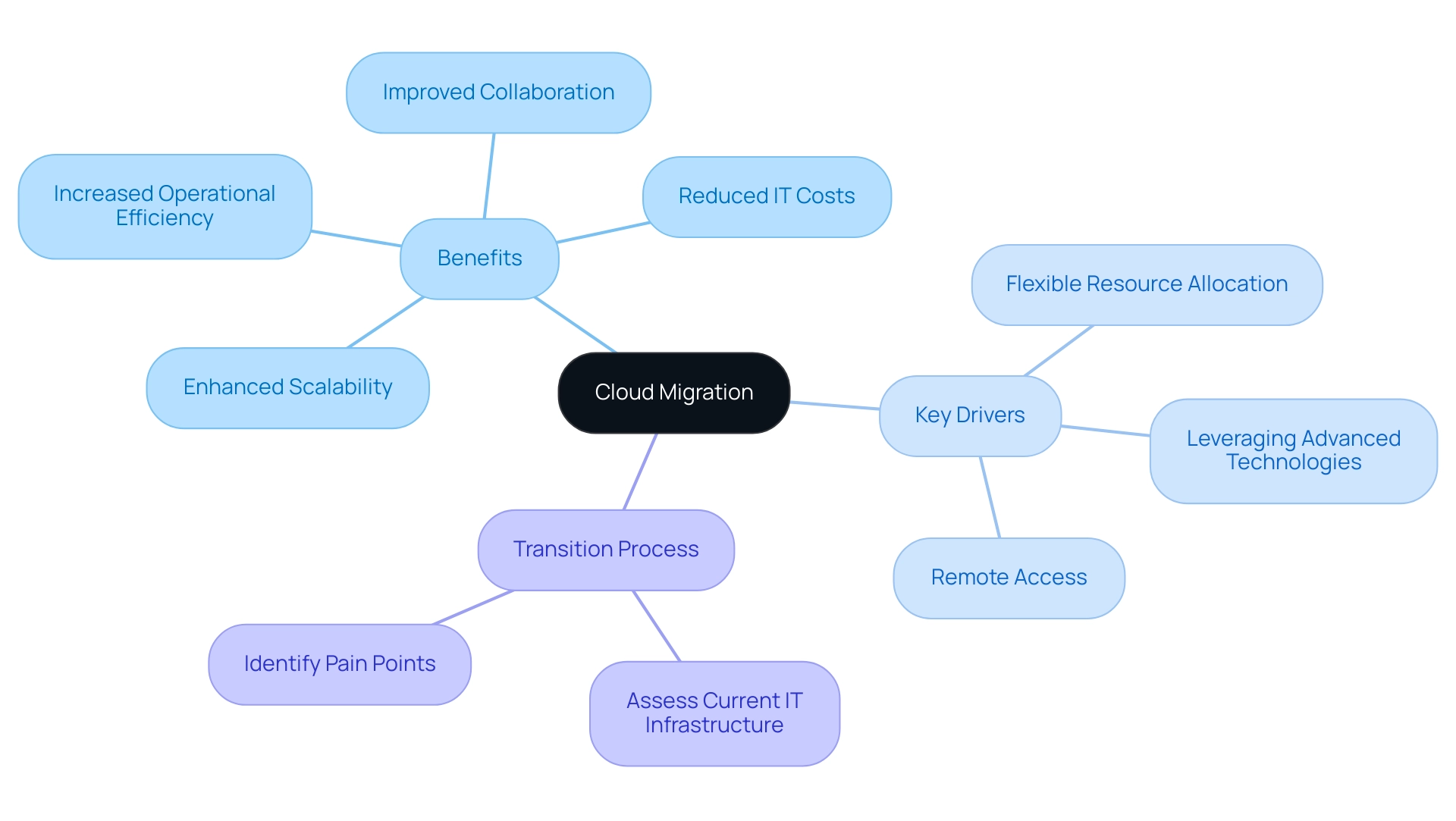
Exploring Cloud Migration Strategies: The 7 Rs Model
The 7 Rs model of digital transition serves as a foundational framework for organizations navigating the complexities of moving on premise to cloud. These strategies include:
- Rehosting (Lift and Shift) - This method involves relocating software to remote servers without any modifications, which can lead to quick migrations but may not optimize performance.
- Refactoring - This strategy involves altering current systems to utilize online features for improved performance and scalability.
- Revising - This approach involves making significant adjustments to submissions, which can improve efficiency but may require substantial development resources.
- Rebuilding - Organizations may choose to create software from the ground up specifically for the cloud, allowing for greater flexibility and integration with cloud-native services.
- Replacing - This entails transitioning to cloud-native solutions, effectively phasing out legacy systems in favor of more modern alternatives.
- Retaining - Certain software may be kept on-premises due to regulatory or performance considerations, necessitating a hybrid model.
- Retiring - Finally, entities might decommission obsolete applications that no longer serve business purposes.
Each of these strategies offers unique advantages and obstacles, making it crucial for companies to thoroughly assess their specific requirements, current infrastructure, and future objectives before choosing a suitable transition method.
Significantly, 75% of companies report a rise in waste associated with online services, highlighting the necessity of thorough planning and evaluation during migration. As part of this process, discovery and assessment are crucial for managing risk, as they involve evaluating existing infrastructure and software. Additionally, case studies like those of Drift, Obsidian, and ResponseTap demonstrate how companies have effectively lowered their computing expenses through successful strategies, enhancing the credibility of the 7 Rs model.
As Gartner observes, the online service market produced more than $152 billion in end-user expenditure in 2021, suggesting a notable change in how entities are utilizing digital technologies for their operational requirements.
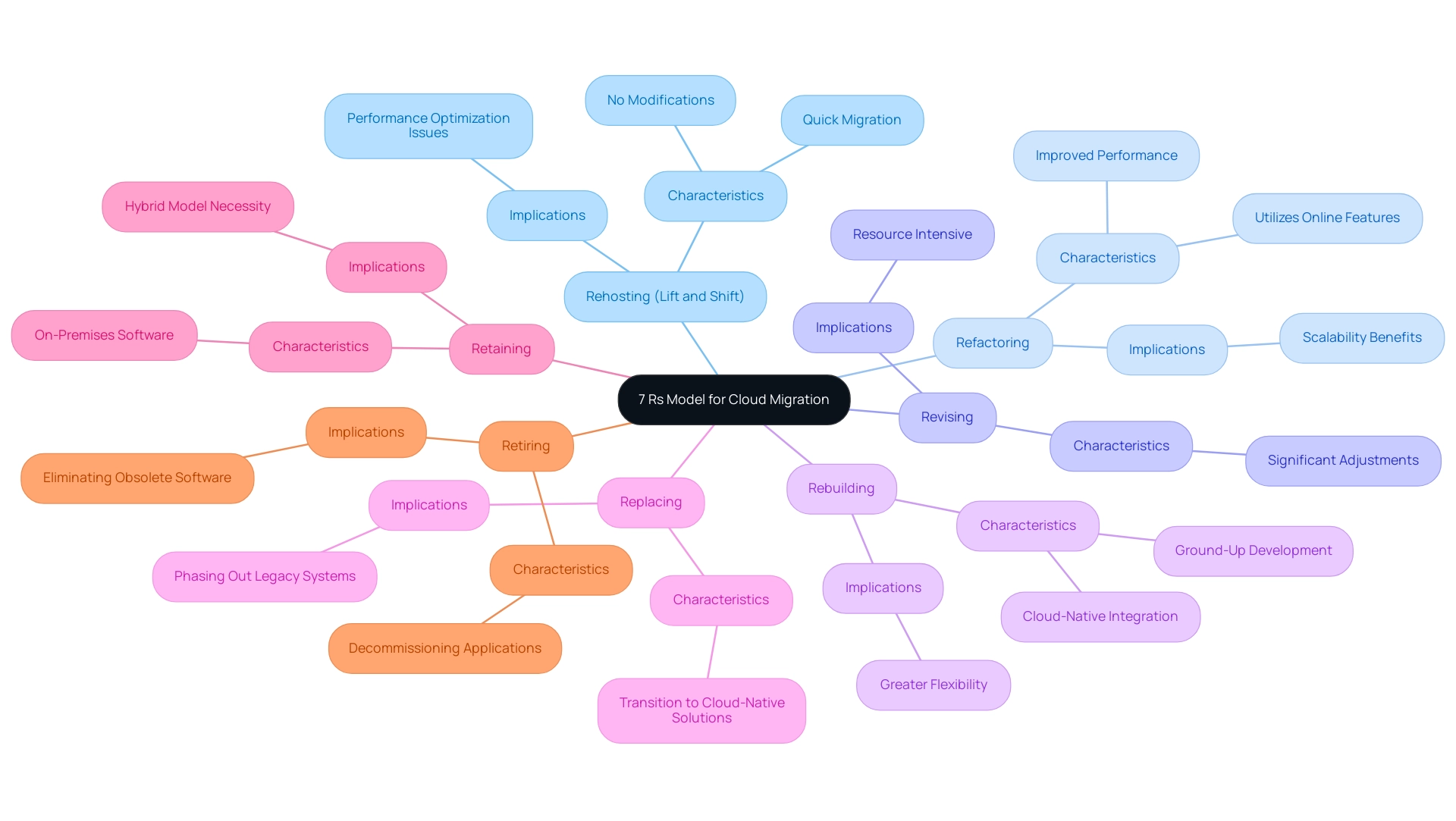
Step-by-Step Guide to Planning Your Migration
-
Assessment: Begin with a comprehensive analysis of your current IT landscape. Accurately identify all applications, data, and workloads slated for moving on premise to cloud, ensuring a clear understanding of their interdependencies and resource requirements. Given that 75% of organizations report an increase in waste associated with online services, a meticulous assessment is critical to avoid unnecessary costs and optimize resource allocation. As nearly 100% of American companies use cloud services, moving on premise to cloud is a foundational step for effective cloud migration.
-
Planning: Formulate a robust transition strategy anchored in the chosen approach from the 7 Rs model (Rehosting, Replatforming, Refactoring, etc.). This strategy for moving on premise to cloud should include detailed timelines, thoughtful resource allocation, and budget considerations to prevent overspending. Effective planning reduces risks and aligns the process of moving on premise to cloud with organizational goals. For instance, Drift successfully reduced its annual cloud expenses by $2.4 million through strategic planning and execution, highlighting the importance of a well-crafted transition strategy.
-
Execution: Implement the transition in a phased manner, commencing with less critical systems. This approach allows for preliminary testing of the migration process, enabling your team to identify and resolve issues before migrating mission-critical workloads. Continuous performance monitoring during this phase is essential to ensure a smooth transition.
-
Evaluation: Thoroughly validate the functionality and performance of migrated software within the online environment. This step is crucial to ensure that the applications operate as expected, meeting the performance benchmarks established during the planning phase.
-
Training: Equip your team with the necessary skills and knowledge to navigate the new online environment. Thorough training and continuous assistance are essential to ensure a seamless transition and enable your staff to utilize online capabilities effectively.
-
Launch: Officially move to the online platform, ensuring that all stakeholders are informed and engaged throughout the process. Clear communication is essential to coordinate efforts and promote a collaborative environment as the organization is moving on premise to cloud. Furthermore, think about refactoring or re-architecting applications to utilize native features for enhanced performance, which is essential for maximizing the advantages of transitioning to a virtual environment.
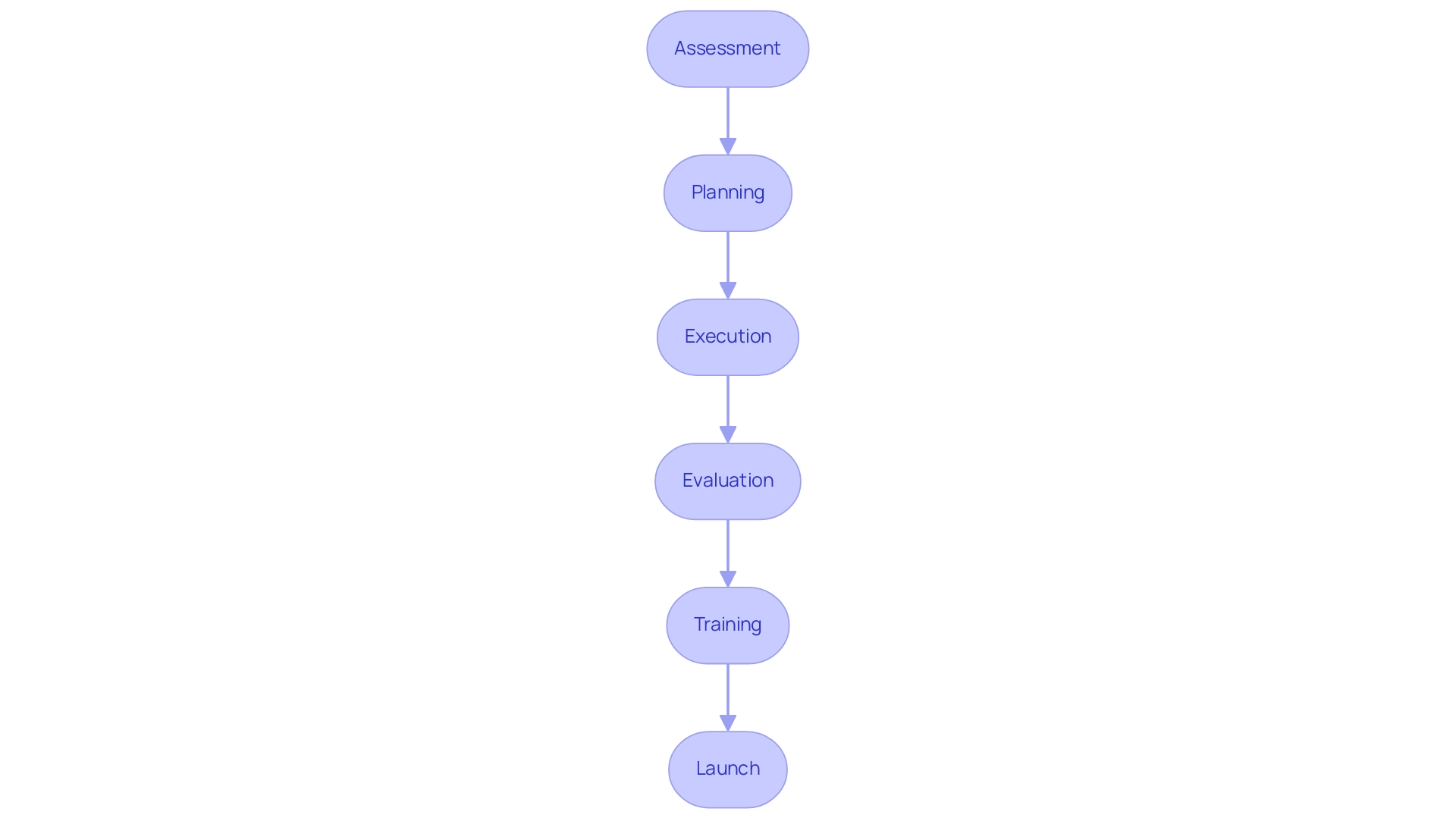
Ensuring Security and Compliance in Cloud Migration
Before starting a migration to the network, it is crucial to perform a thorough risk evaluation focused on recognizing potential vulnerabilities within your current infrastructure. This foundational step allows entities to understand and mitigate risks effectively. Implementing robust security measures is essential; these should encompass:
- Data encryption
- Stringent access controls
- Regular audits to ensure compliance with industry standards and regulations such as GDPR and HIPAA
In light of recent statistics indicating that phishing is implicated in over 25% of security attacks, organizations must prioritize reinforcing their defenses against such threats. Moreover, a clear data governance policy should be established to oversee data access and usage in the digital environment. This policy will act as a framework for managing sensitive information and maintaining compliance throughout the transition process.
Regularly reviewing and updating security protocols is crucial to adapting to the evolving landscape of threats and compliance requirements. Significantly, in 2023, crypto mining was detected in two-thirds of online compromises, emphasizing the necessity for vigilance in security practices. Additionally, the financial implications of inadequate security measures are staggering; the average total cost of a mega breach, involving 50-60 million records, was $332 million.
By prioritizing these measures, organizations can navigate the complexities of moving on premise to cloud while safeguarding their data integrity. As highlighted by 72% of IT security leaders, this technology is ranked as their companies’ top priority for digital transformation, further emphasizing the critical nature of these security considerations.
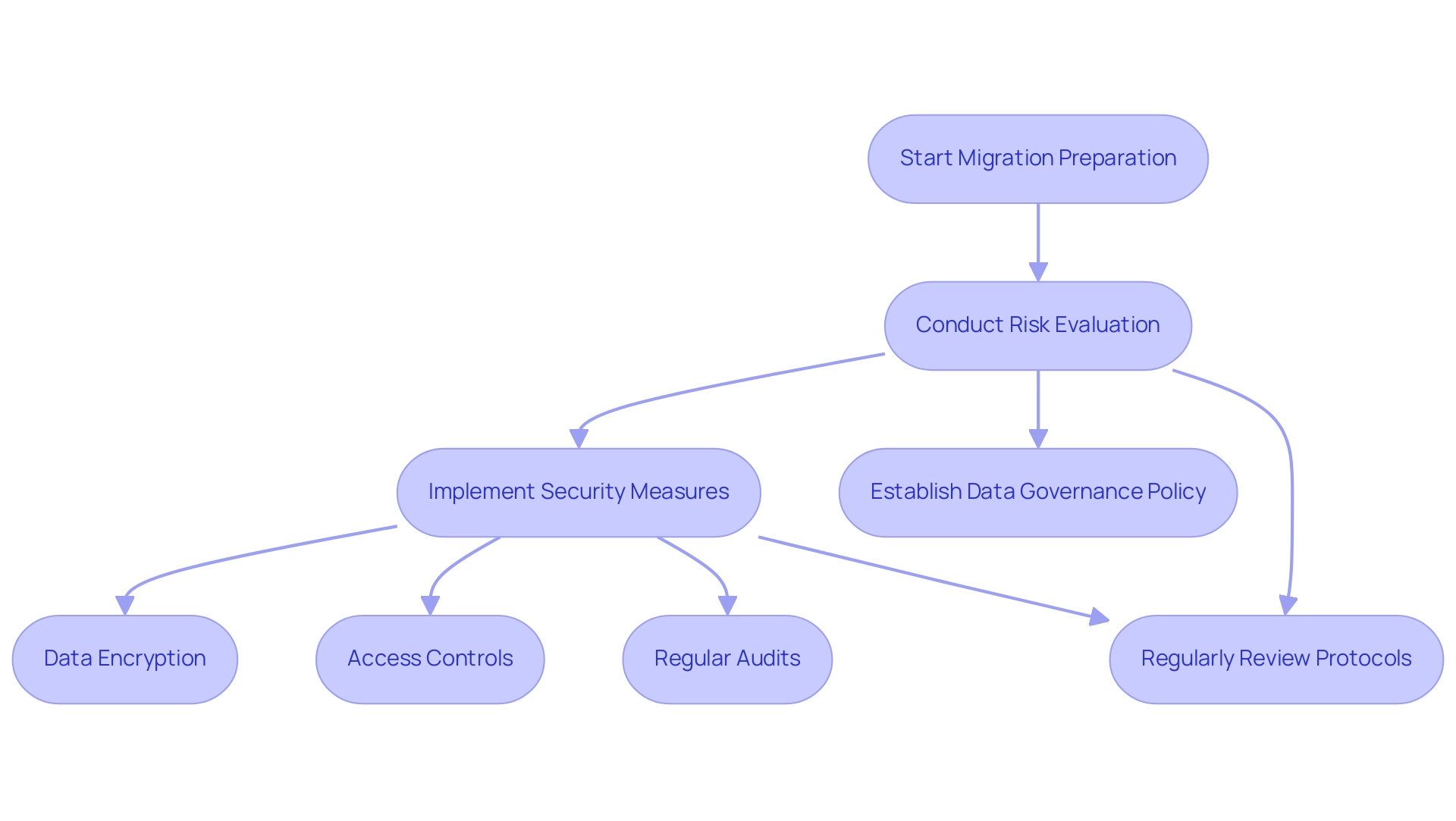
Post-Migration: Optimization and Management Strategies
Following a successful migration to the digital environment, it is imperative to maintain vigilant oversight of performance and usage to pinpoint areas ripe for optimization. Utilizing advanced management tools can greatly assist in scrutinizing resource utilization, costs, and performance metrics effectively. With 57% of large enterprises now utilizing multi-cloud FinOps tools, the landscape of cost management has evolved, necessitating robust strategies for optimization.
For instance, Drift successfully reduced its costs by $2.4 million through effective expense management practices, illustrating the potential benefits of a well-implemented strategy. Implementing auto-scaling capabilities is essential, as it allows for dynamic resource adjustments based on demand, thereby ensuring cost-effectiveness. Regular assessments of your digital strategy are crucial to ensure alignment with continually evolving business objectives and the latest technological advancements.
Furthermore, cultivating a culture of training and development within your team is essential; keeping them aware of best practices and new features in the digital environment will improve performance optimization efforts. As highlighted by Cody Slingerland, a substantial segment of the market, especially in two key areas, represents 82% of the global computing services, emphasizing the competitive nature of management in this sector and the necessity for effective practices. Furthermore, with Google Cloud's IaaS offering growing the fastest at 63%, organizations must stay informed about current trends in cloud optimization strategies to remain competitive.
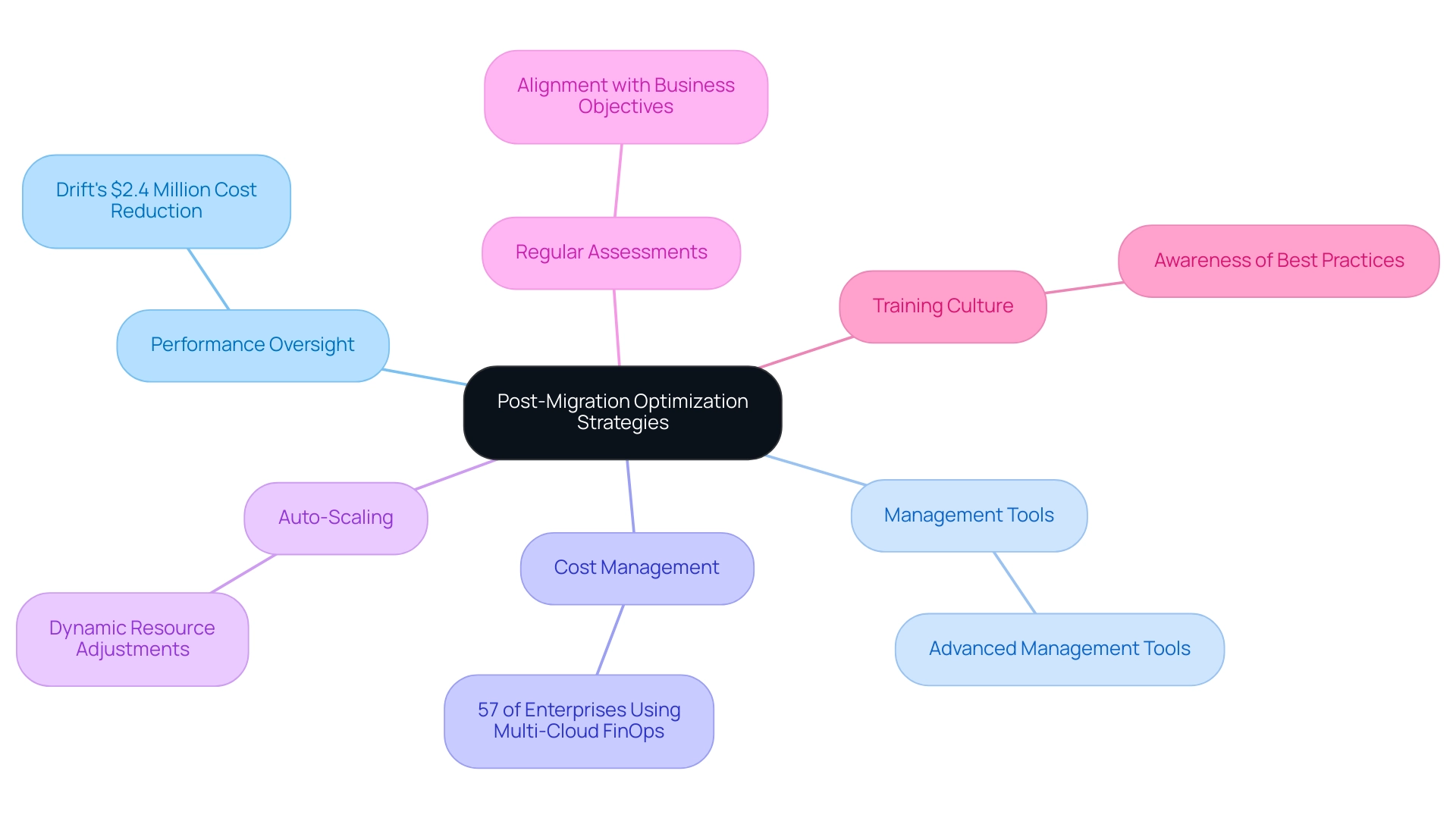
Conclusion
The journey to cloud migration presents organizations with unparalleled opportunities for growth and innovation. By embracing cloud technology, businesses can enhance scalability, reduce IT expenditures, and improve collaboration, thereby achieving greater operational efficiency. The significant investment in cloud solutions, particularly by leading providers like AWS, Microsoft Azure, and Google Cloud, underscores the urgency for organizations to adapt to this transformative landscape.
Utilizing strategic frameworks such as the 7 Rs model allows businesses to navigate the complexities of migration effectively. Each strategy, from rehosting to retiring applications, offers distinct advantages and necessitates careful consideration of organizational needs and existing infrastructure. A thorough assessment and robust planning process are crucial to mitigate risks and optimize resource allocation, while case studies highlight the tangible benefits of well-executed migration strategies.
Security and compliance emerge as paramount concerns during the migration process. Implementing stringent security measures and maintaining a clear data governance policy are essential steps in safeguarding sensitive information. With the evolving landscape of cyber threats, organizations must prioritize resilience and adaptability to protect their data integrity throughout their cloud journey.
Finally, post-migration optimization and management are vital for maximizing the benefits of cloud technology. Continuous monitoring and resource management not only enhance performance but also ensure that organizations remain aligned with their evolving business objectives. As the digital landscape continues to evolve, staying informed about current trends and best practices in cloud management will be key to maintaining a competitive advantage. Through careful planning, execution, and ongoing management, organizations can harness the full potential of cloud migration and position themselves for success in an increasingly digital world.




